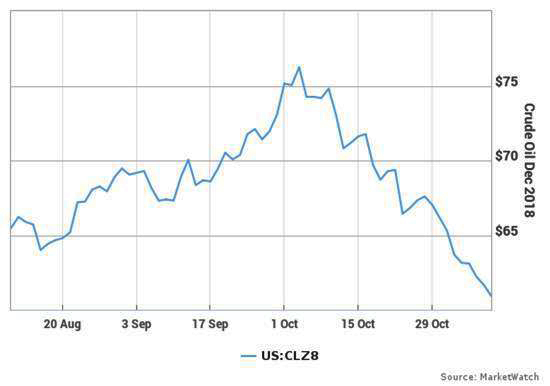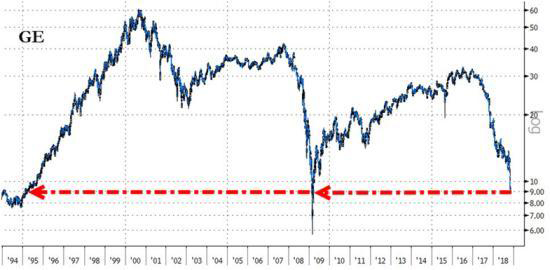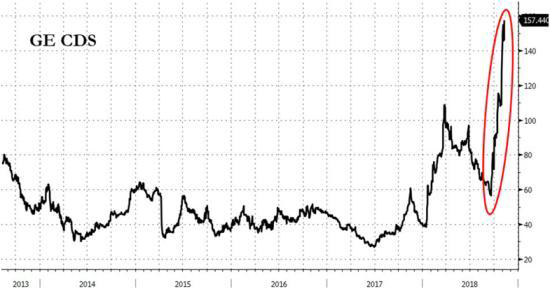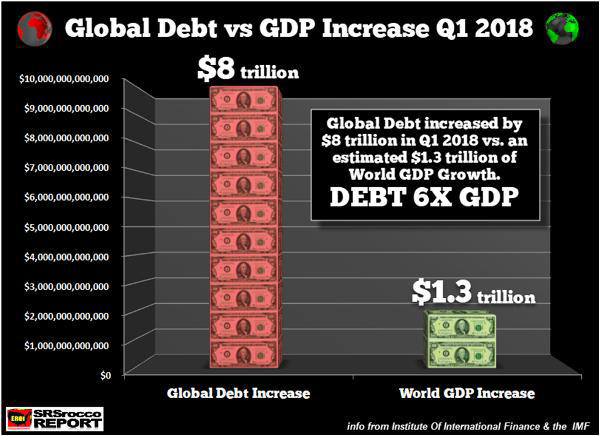Oil And General Electric Join The Roll-Over Parade
John Rubino
 First developing countries blew up. Then real estatetopped and started to roll over. Now oil has entered what CNBC just called its “longest losing streak in three decades.” First developing countries blew up. Then real estatetopped and started to roll over. Now oil has entered what CNBC just called its “longest losing streak in three decades.”
In a volatile turnabout, the U.S. crude benchmark fell into a bear market Thursday just five weeks after hitting a nearly four-year high.
West Texas Intermediate crude for December delivery on the New York Mercantile Exchange fell $1, or 1.7%, to settle at $60.67 a barrel, marking its ninth straight losing session and the lowest close since March. The finish left U.S. oil down 20.6% from its Oct. 3 peak, meeting a widely applied definition of a bear market as a pullback of 20% from a recent high.

October marked a reversal for the crude-oil market, which had rallied sharply in 2018, with gains fueled in part by fears that the Trump administration’s renewal of sanctions against Iran, bottlenecks in U.S. shale-oil producing regions and strong domestic economic growth would tighten the oil market. WTI hit a nearly four-year high above $76 a barrel on Oct. 3, while Brent crude the global benchmark, topped $86 a barrel. Brent is off more than 18% from its recent high.
Meanwhile, General Electric, which has fingers in pretty much every global industrial pie is, it’s fair to say, imploding:
(Zero Hedge) – Following yet another downgrade, by JPMorgan this time, GE is trading back with an $8 handle for the first time since its crash in the financial crisis (and unchanged since 1995).

Specifically, JPMorgan analyst Stephen Tusa cut his price target to $6 from previous $10. The current target is the lowest among all the analysts covering the stock, according to data compiled by Bloomberg.
“While the stock is down about 70 percent from the peak of $30, this move still does not sufficiently reflect the fundamental facts,” Tusa wrote in a note.
Tusa, who has carried the equivalent of a sell rating on GE since May 2016, said he expected continued erosion in the stock, given ongoing fundamental declines in power-related businesses, high leverage and a weak free cash flow.
“We are skeptical around calls for a bottom until management resets EPS expectations that are closer to free cash flow, something we believe they haven’t done for almost 20 years.”
And GE default risk is surging…

What does this mean? Well, it might mean that the “marginal productivity of debt” is finally approaching zero. Here’s a chart from the SRSRocco Report showing that in 2018’s first quarter the world needed $8 trillion of new debt to generate barely $1 trillion of new wealth.

Now, with interest rates rising on that old debt, the cost of past mistakes may at last be exceeding the gains from new investment, pushing the marginal utility of debt to zero or below.
If true, the party’s over. When new debt produces not just a low return but a negative one, a credit-addicted system is analogous to a heroin addict for whom the necessary dose is also a fatal one.
Which doesn’t mean the addict won’t try. At some point in the coming year the world’s central banks will be forced back to the needle, with the Fed reversing its recent tightening and the ECB and BoJ ramping up their existing QE programs. The question is whether this next, biggest-ever liquidity injection will have the same effect as in the past, or a very different one.

DollarCollapse.com is managed by John Rubino, co-author, with James Turk, of The Money Bubble (DollarCollapse Press, 2014) andÊThe Collapse of the Dollar and How to Profit From It (Doubleday, 2007), and author of Clean Money: Picking Winners in the Green-Tech Boom (Wiley, 2008), How to Profit from the Coming Real Estate Bust (Rodale, 2003) and Main Street, Not Wall Street (Morrow, 1998). After earning a Finance MBA from New York University, he spent the 1980s on Wall Street, as a Eurodollar trader, equity analyst and junk bond analyst. During the 1990s he was a featured columnist with TheStreet.com and a frequent contributor to Individual Investor, Online Investor, and Consumers Digest, among many other publications. He currently writes for CFA Magazine.
dollarcollapse.com
| 

![[Most Recent Quotes from www.kitco.com]](http://www.kitconet.com/charts/metals/gold/t24_au_en_usoz_2.gif)
![[Most Recent USD from www.kitco.com]](http://www.weblinks247.com/indexes/idx24_usd_en_2.gif)
![[Most Recent Quotes from www.kitco.com]](http://www.kitconet.com/charts/metals/silver/t24_ag_en_usoz_2.gif)


